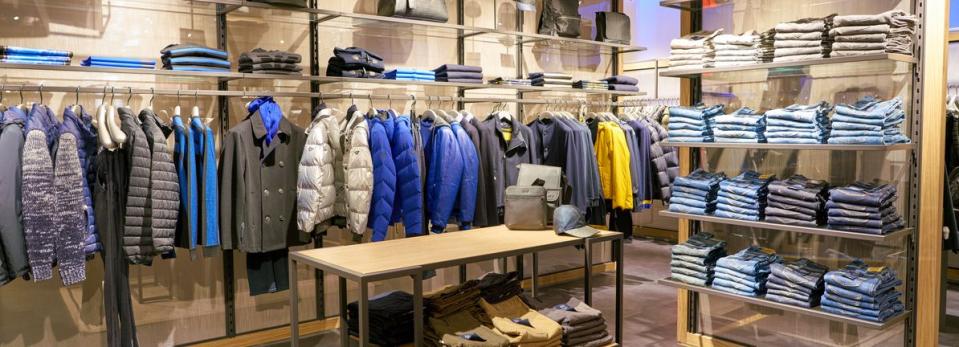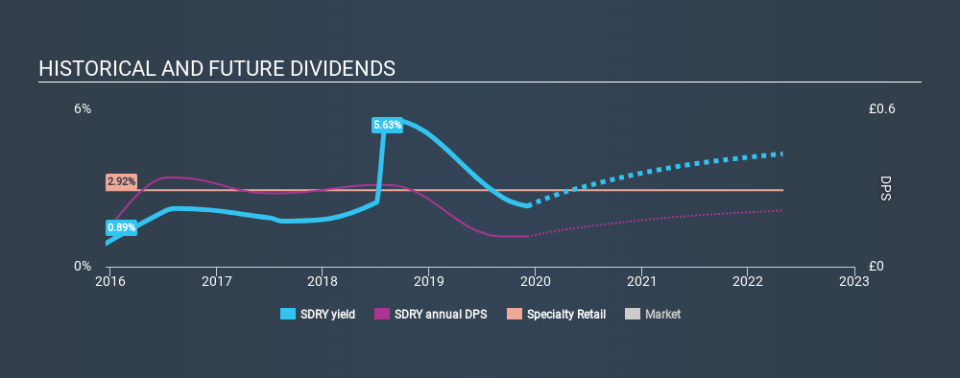Is Superdry Plc (LON:SDRY) A Risky Dividend Stock?

Could Superdry Plc (LON:SDRY) be an attractive dividend share to own for the long haul? Investors are often drawn to strong companies with the idea of reinvesting the dividends. On the other hand, investors have been known to buy a stock because of its yield, and then lose money if the company's dividend doesn't live up to expectations.
Investors might not know much about Superdry's dividend prospects, even though it has been paying dividends for the last four years and offers a 2.3% yield. While the yield may not look too great, the relatively long payment history is interesting. Some simple analysis can offer a lot of insights when buying a company for its dividend, and we'll go through this below.
Click the interactive chart for our full dividend analysis
Payout ratios
Dividends are usually paid out of company earnings. If a company is paying more than it earns, then the dividend might become unsustainable - hardly an ideal situation. So we need to form a view on if a company's dividend is sustainable, relative to its net profit after tax. While Superdry pays a dividend, it reported a loss over the last year. When a company is loss-making, we next need to check to see if its cash flows can support the dividend.
Superdry paid out 192% of its free cash flow last year, which we think is concerning if cash flows do not improve. Paying out such a high percentage of cash flow suggests that the dividend was funded from either cash at bank or by borrowing, neither of which is desirable over the long term.
While the above analysis focuses on dividends relative to a company's earnings, we do note Superdry's strong net cash position, which will let it pay larger dividends for a time, should it choose.
We update our data on Superdry every 24 hours, so you can always get our latest analysis of its financial health, here.
Dividend Volatility
One of the major risks of relying on dividend income, is the potential for a company to struggle financially and cut its dividend. Not only is your income cut, but the value of your investment declines as well - nasty. Superdry has been paying a dividend for the past four years. This company's dividend has been unstable, and with a relatively short history, we think it's a little soon to draw strong conclusions about its long term dividend potential. During the past four-year period, the first annual payment was UK£0.12 in 2015, compared to UK£0.12 last year. The dividend has shrunk at around 1.9% a year during that period. Superdry's dividend has been cut sharply at least once, so it hasn't fallen by 1.9% every year, but this is a decent approximation of the long term change.
We struggle to make a case for buying Superdry for its dividend, given that payments have shrunk over the past four years.
Dividend Growth Potential
With a relatively unstable dividend, it's even more important to see if earnings per share (EPS) are growing. Why take the risk of a dividend getting cut, unless there's a good chance of bigger dividends in future? Superdry's EPS have fallen by approximately 12% per year during the past five years. With this kind of significant decline, we always wonder what has changed in the business. Dividends are about stability, and Superdry's earnings per share, which support the dividend, have been anything but stable.
Conclusion
To summarise, shareholders should always check that Superdry's dividends are affordable, that its dividend payments are relatively stable, and that it has decent prospects for growing its earnings and dividend. We're a bit uncomfortable with Superdry paying a dividend while loss-making, especially since the dividend was also not well covered by free cash flow. Earnings per share are down, and Superdry's dividend has been cut at least once in the past, which is disappointing. There are a few too many issues for us to get comfortable with Superdry from a dividend perspective. Businesses can change, but we would struggle to identify why an investor should rely on this stock for their income.
Given that earnings are not growing, the dividend does not look nearly so attractive. Businesses can change though, and we think it would make sense to see what analysts are forecasting for the company.
Looking for more high-yielding dividend ideas? Try our curated list of dividend stocks with a yield above 3%.
If you spot an error that warrants correction, please contact the editor at editorial-team@simplywallst.com. This article by Simply Wall St is general in nature. It does not constitute a recommendation to buy or sell any stock, and does not take account of your objectives, or your financial situation. Simply Wall St has no position in the stocks mentioned.
We aim to bring you long-term focused research analysis driven by fundamental data. Note that our analysis may not factor in the latest price-sensitive company announcements or qualitative material. Thank you for reading.

 Yahoo Finance
Yahoo Finance 
